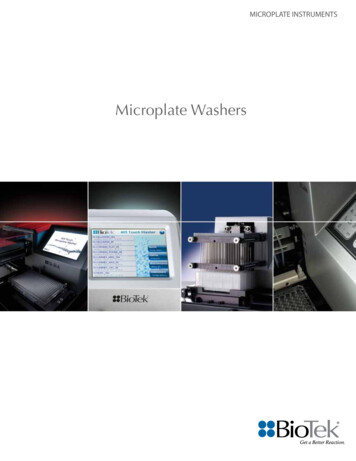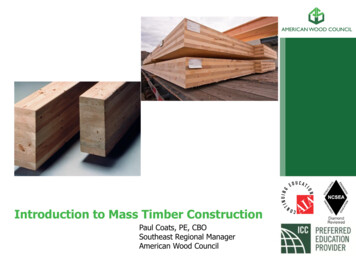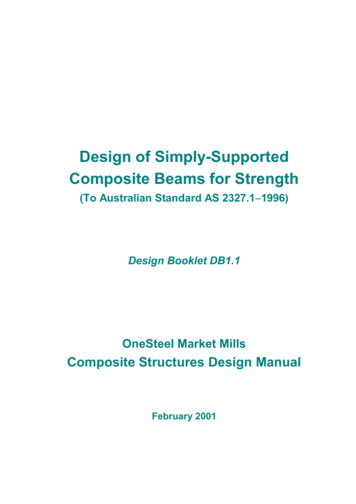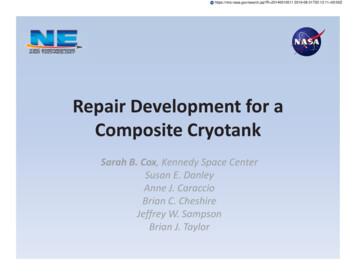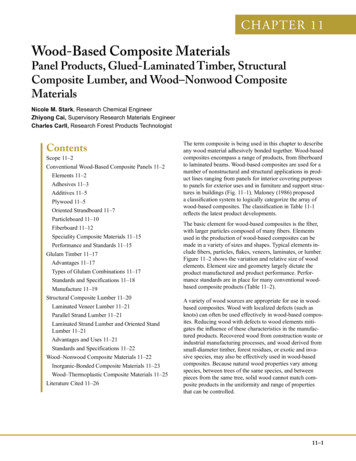
Transcription
LAMINATED COMPOSITE PLATESDavid RoylanceDepartment of Materials Science and EngineeringMassachusetts Institute of TechnologyCambridge, MA 02139February 10, 2000IntroductionThis document is intended to outline the mechanics of fiber-reinforced laminated plates, leadingto a computational scheme that relates the in-plane strain and curvature of a laminate to thetractions and bending moments imposed on it. Although this is a small part of the overall fieldof fiber-reinforced composites, or even of laminate theory, it is an important technique thatshould be understood by all composites engineers.In the sections to follow, we will review the constitutive relations for isotropic materials inmatrix form, then show that the extension to transversely isotropic composite laminae is verystraightforward. Since each ply in a laminate may be oriented arbitrarily, we will then showhow the elastic properties of the individual laminae can be transformed to a common direction.Finally, we will balance the individual ply stresses against the applied tractions and momentsto develop matrix governing relations for the laminate as a whole.The calculations for laminate mechanics are best done by computer, and algorithms areoutlined for elastic laminates, laminates exhibiting thermal expansion effects, and laminatesexhibiting viscoelastic response.Isotropic linear elastic materialsAs shown in elementary texts on Mechanics of Materials (cf. Roylance 19961 ), the Cartesianstrains resulting from a state of plane stress (σz τxz τyz 0) are x 1(σx νσy )E y 1(σy νσx )E1τxyGIn plane stress there is also a strain in the z direction due to the Poisson effect: z ν (σx σy );this strain component will be ignored in the sections to follow. In the above relations there arethree elastic constants: the Young’s modulus E, Poisson’s ratio ν, and the shear modulusγxy 1See References listed at the end of this document.1
G. However, for isotropic materials there are only two independent elastic constants, and forinstance G can be obtained from E and ν asG E2(1 ν)Using matrix notation, these relations can be written as x x γxy 1/E ν/E0 σx 0 ν/E 1/Eσ y 001/G τxy (1) The quantity in brackets is called the compliance matrix of the material, denoted S or Sij . Itis important to grasp the physical significance of its various terms. Directly from the rules ofmatrix multiplication, the element in the ith row and j th column of Sij is the contribution of thej th stress to the ith strain. For instance the component in the 1,2 position is the contributionof the y-direction stress to the x-direction strain: multiplying σy by 1/E gives the y-directionstrain generated by σy , and then multiplying this by ν gives the Poisson strain induced inthe x direction. The zero elements show the lack of coupling between the normal and shearingcomponents.If we wish to write the stresses in terms of the strains, Eqn. 1 can be inverted to give: σx σy τxy 1 ν0 xE 0 ν 1 y1 ν2 0 0 (1 ν)/2 γxy (2) where here G has been replaced by E/2(1 ν). This relation can be abbreviated further as:σ D (3)where D S 1 is the stiffness matrix. Note that the Young’s modulus can be recovered bytaking the reciprocal of the 1,1 element of the compliance matrix S, but that the 1,1 position ofthe stiffness matrix D contains Poisson effects and is not equal to E.Anisotropic MaterialsIf the material has a texture like wood or unidirectionally-reinforced fiber composites as shown inFig. 1, the modulus E1 in the fiber direction will typically be larger than those in the transversedirections (E2 and E3 ). When E1 6 E2 6 E3 , the material is said to be orthotropic. It iscommon, however, for the properties in the plane transverse to the fiber direction to be isotropicto a good approximation (E2 E3 ); such a material is called transversely isotropic. The elasticconstitutive laws must be modified to account for this anisotropy, and the following form is anextension of the usual equations of isotropic elasticity to transversely isotropic materials: 1 2 γ12 1/E1 ν21 /E20 σ1 ν12 /E11/E20σ 2 001/G12 τ12 (4)The parameter ν12 is the principal Poisson’s ratio; it is the ratio of the strain induced in the2-direction by a strain applied in the 1-direction. This parameter is not limited to values lessthan 0.5 as in isotropic materials. Conversely, ν21 gives the strain induced in the 1-direction by2
.Figure 1: An orthotropic material.a strain applied in the 2-direction. Since the 2-direction (transverse to the fibers) usually hasmuch less stiffness than the 1-direction, a given strain in the 1-direction will usually develop amuch larger strain in the 2-direction than will the same strain in the 2-direction induce a strainin the 1-direction. Hence we will usually have ν12 ν21 . There are five constants in the aboveequation (E1 , E2 , ν12 , ν21 and G12 ). However, only four of them are independent; since the Smatrix is symmetric, we have ν21 /E2 ν12 /E1 .The simple form of Eqn. 4, with zeroes in the terms representing coupling between normaland shearing components, is obtained only when the axes are aligned along the principal materialdirections; i.e. along and transverse to the fiber axes. If the axes are oriented along some otherdirection, all terms of the compliance matrix will be populated, and the symmetry of the materialwill not be evident. If for instance the fiber direction is off-axis from the loading direction, thematerial will develop shear strain as the fibers try to orient along the loading direction. Therewill therefore be a coupling between a normal stress and a shearing strain, which does not occurin an isotropic material.Transformation of AxesIt is important to be able to transform the axes to and from the “laboratory” x y frame to anatural material frame in which the axes might be labeled 1 2 corresponding to the fiber andtransverse directions as shown in Fig. 2.Figure 2: Rotation of axes.As shown in elementary textbooks, the transformation law for Cartesian Cauchy stress can3
be written:σ1 σx cos2 θ σy sin2 θ 2τxy sin θ cos θσ2 σx sin2 θ σy cos2 θ 2τxy sin θ cos θτ12 (σy σx ) sin θ cos θ τxy (cos2 θ sin2 θ)(5)Where θ is the angle from the x axis to the 1 (fiber) axis. These relations can be written inmatrix form as σ1 σ2 τ12 c2 s22sc σx 2 2 sc 2sc σ y sc sc c2 s2 τxy (6) where c cos θ and s sin θ. This can be abbreviated asσ 0 Aσ(7)where A is the transformation matrix in brackets above. This expression could be applied tothree-dimensional as well as two-dimensional stress states, although the particular form of Agiven in Eqn. 6 is valid in two dimensions only (plane stress), and for Cartesian coordinates.Using either mathematical or geometric arguments, it can be shown that the components ofinfinitesimal strain transform by almost the same relations: 1 2 A 1 2 γ12 x y 12 γxy(8)The factor of 1/2 on the shear components arises from the classical definition of shear strain,which is twice the tensorial shear strain. This introduces some awkwardness into the transformation relations, which can be reduced by introducing the Reuter’s matrix, defined as 1 0 0 [R] 0 1 0 0 0 2 [R] 1or 1 0 0 0 1 0 0 0 12(9)We can now write: 1 2 γ12 1 R 2 1γ2 12 x RA y 1γ2 xy RAR 1 x y γ xyOr 0 RAR 1 (10)The transformation law for compliance can now be developed from the transformation lawsfor strains and stresses. By successive transformations, the strain in an arbitrary x-y directionis related to strain in the 1-2 (principal material) directions, then to the stresses in the 1-2directions, and finally to the stresses in the x-y directions. The final grouping of transformationmatrices relating the x-y strains to the x-y stresses is then the transformed compliance matrixin the x-y direction:4
x y γxy x R y RA 1 1γ 2 xy RA 1 R 1 S σ1 σ2 τ 12 1 1 2 RA 1 R 1 2 γ 1122 γ12 RA 1 R 1 SA σx σy τ xy S σx σy τ xywhere S is the transformed compliance matrix relative to x-y axes. The inverse of S is D, thestiffness matrix relative to x-y axes:S RA 1 R 1 SA, 1D S(11)Example 1Consider a ply of Kevlar-epoxy composite with a stiffnesses E1 82, E2 4, G12 2.8 (all GPa) andν12 0.25. oriented at 30 from the x axis. The stiffness in the x direction can be found as the reciprocalof the 1,1 element of the transformed compliance matrix S, as given by Eqn. 11. The following showshow this can be done with Maple symbolic mathematics software (edited for brevity):Read linear algebra package with(linalg):Define compliance matrix S: 1/E[2],0],[0,0,1/G[12]]]);Numerical parameters for Kevlar-epoxy Digits: 4;unprotect(E);E[1]: 82e9;E[2]: 4e9;G[12]: 2.8e9;nu[12]: .25;nu[21]: nu[12]*E[2]/E[1];Compliance matrix evaluated S2: map(eval,S); .1220 10 10S2 : .3049 10 110 .3050 10 11.2500 10 90 0 0.3571 10 9Transformation matrix A: matrix(3,3,[[c 2,s 2,2*s*c],[s 2,c 2,-2*s*c],[-s*c,s*c,c 2-s 2]]);Trigonometric relations and angle s: sin(theta);c: cos(theta);theta: 30*Pi/180;Transformation matrix evaluated A2: evalf(map(eval,A)); .7500 .2500 .8660A2 : .2500 .7500 .8660 .4330 .4330 .5000Reuter’s matrix R: matrix(3,3,[[1,0,0],[0,1,0],[0,0,2]]);Transformed compliance matrix Sbar: evalf(evalm( R &* inverse(A2) &* inverse(R) &* S2 &* A2 ));5
.8828 10 10 .1968 10 10 .2071 10 9Sbar : .1969 10 10 9 .1222 10 .8377 10 10 .1222 10 9 .8370 10 10 .2905 10 9Stiffness in x-direction ’E[x]’ 1/Sbar[1,1];Ex .1133 1011Note that the transformed compliance matrix is symmetric (to within numerical roundoff error), butthat nonzero coupling values exist. A user not aware of the internal composition of the material wouldconsider it completely anisotropic.Laminated composite platesOne of the most common forms of fiber-reinforced composite materials is the crossplied laminate,in which the fabricator “lays up” a sequence of unidirectionally reinforced “plies” as indicated inFig. 3. Each ply is typically a thin (approximately 0.2 mm) sheet of collimated fibers impregnatedwith an uncured epoxy or other thermosetting polymer matrix material. The orientation ofeach ply is arbitrary, and the layup sequence is tailored to achieve the properties desired of thelaminate. In this section we outline how such laminates are designed and analyzed.Figure 3: A 3-ply symmetric laminate.“Classical Laminate Theory” is an extension of the theory for bending of homogeneous plates,but with an allowance for in-plane tractions in addition to bending moments, and for the varyingstiffness of each ply in the analysis. In general cases, the determination of the tractions andmoments at a given location will require a solution of the general equations for equilibrium anddisplacement compatibility of plates. This theory is treated in a number of standard texts2 , andwill not be discussed here.We begin by assuming a knowledge of the tractions N and moments M applied to a plateat a position x, y, as shown in Fig. 4:N 2 Nx M Ny N xy Mx My M xy(12)cf. S. Timoshenko and S. Woinowsky-Krieger, Theory of Plates and Shells, McGraw-Hill, New York, 1959.6
.Figure 4: Applied moments in plate bending.It will be convenient to normalize these tractions and moments by the width of the plate, so theyhave units of N/m and N-m/m, or simply N, respectively. Coordinates x and y are the directionsin the plane of the plate, and z is customarily taken as positive downward. The deflection inthe z direction is termed w, also taken as positive downward.Figure 5: Displacement of a point in a plate (from Powell, 1983).Analogously with the Euler assumption for beams, the Kirshchoff assumption for plate bending takes initially straight vertical lines to remain straight but rotate around the midplane(z 0). As shown in Fig. 5, the horizontal displacements u and v in the x and y directions dueto rotation can be taken to a reasonable approximation from the rotation angle and distancefrom midplane, and this rotational displacement is added to the midplane displacement (u0 , v0 ):u u0 z w0,x(13)v v0 z w0,y(14)The strains are just the gradients of the displacements; using matrix notation these can bewritten7
x y γxy u,xu0,x z w0,xx v,y v0,y z w0,yy 0 z κ u v (u v ) 2z w ,y,x0,y0,x0,xy(15)where 0 is the midplane strain and κ is the vector of second derivatives of the displacement,called the curvature: κx κ κy κ xy w0,xx w0,yy 2w 0,xyThe component κxy is a twisting curvature, stating how the x-direction midplane slope changeswith y (or equivalently how the y-direction slope changes with x).The stresses relative to the x-y axes are now determined from the strains, and this musttake consideration that each ply will in general have a different stiffness, depending on itsown properties and also its orientation with respect to the x-y axes. This is accounted for bycomputing the transformed stiffness matrix D as described in the previous section (Eqn. 11).Recall that the ply stiffnesses as given by Eqn. 4 are those along the fiber and transversedirections of that particular ply. The properties of each ply must be transformed to a commonx-y axes, chosen arbitrarily for the entire laminate. The stresses at any vertical position arethen:σ D D 0 zDκ(16)where here D is the transformed stiffness of the ply at the position at which the stresses arebeing computed.Each of these ply stresses must add to balance the traction per unit width N:N Z h/2 h/2σ dz N ZXzk 1k 1 zkσ k dz(17)where σk is the stress in the kth ply and zk is the distance from the laminate midplane to thebottom of the kth ply. Using Eqn. 16 to write the stresses in terms of the mid-plane strains andcurvatures:N N ZXzk 1zkk 10D dz Zzk 1zk Dκz dz(18)The curvature κ and midplane strain 0 are constant throughout z, and the transformed stiffnessD does not change within a given ply. Removing these quantities from within the integrals:N N XD 0k 1Zzk 1zkdz DκZzk 1zk z dz(19)After evaluating the integrals, this expression can be written in the compact form:N A 0 Bκwhere A is an “extensional stiffness matrix” defined as:8(20)
A NXD(zk 1 zk )(21)k 1and B is a “coupling stiffness matrix” defined as:B N1X2D(zk 1 zk2 )2 k 1(22)The rationale for the names “extensional” and “coupling” is suggested by Eqn. 20. The Amatrix gives the influence of an extensional mid-plane strain 0 on the inplane traction N, andthe B matrix gives the contribution of a curvature κ to the traction. It may not be obviouswhy bending the plate will require an in-plane traction, or conversely why pulling the plate inits plane will cause it to bend. But visualize the plate containing plies all of the same stiffness,except for some very low-modulus plies somewhere above its midplane. When the plate is pulled,the more compliant plies above the midplane will tend to stretch more than the stiffer plies belowthe midplane. The top half of the laminate stretches more than the bottom half, so it takes ona concave-downward curvature.Similarly, the moment resultants per unit width must be balanced by the moments contributed by the internal stresses:M Z h/2 h/2σz dz B 0 Dκ(23)where D is a “bending stiffness matrix” defined as:N1X3D D(zk 1 zk3 )3 k 1(24)The complete set of relations between applied forces and moments, and the resulting midplane strains and curvatures, can be summarized as a single matrix equation:(NM)" A BB D#( 0κ)(25)The A/B/B/D matrix in brackets is the laminate stiffness matrix, and its inverse will be thelaminate compliance matrix.The presence of nonzero elements in the coupling matrix B indicates that the application ofan in-plane traction will lead to a curvature or warping of the plate, or that an applied bendingmoment will also generate an extensional strain. These effects are usually undesirable. However,they can be avoided by making the laminate symmetric about the midplane, as examinationof Eqn. 22 can reveal. (In some cases, this extension-curvature coupling can be used as aninteresting design feature. For instance, it is possible to design a composite propeller bladewhose angle of attack changes automatically with its rotational speed: increased speed increasesthe in-plane centripetal loading, which induces a twist into the blade.)The above relations provide a straightforward (although tedious, unless a computer is used)means of determining stresses and displacements in laminated composites subjected to in-planetraction or bending loads:9
1. For each material type in the stacking sequence, obtain by measurement or micromechanical estimation the four independent anisotropic parameters appearing in Eqn. 4: (E1 , E2 ,ν12 , and G12 ).2. Using Eqn. 11, transform the compliance matrix for each ply from the ply’s principalmaterial directions to some convenient reference axes that will be used for the laminate asa whole.3. Invert the transformed compliance matrix to obtain the transformed (relative to x-y axes)stiffness matrix D.4. Add each ply’s contribution to the A, B and D matrices as prescribed by Eqns. 21, 22 and24.5. Input the prescribed tractions N and bending moments M, and form the system equationsgiven by Eqn. 25.6. Solve the resulting system for the unknown values of in-plane strain 0 and curvature κ.7. Use Eqn. 16 to determine the ply stresses for each ply in the laminate in terms of 0 , κand z. These will be the stresses relative to the x-y axes.8. Use Eqn. 6 to transform the x-y stresses back to the principal material axes (parallel andtransverse to the fibers).9. If desired, the individual ply stresses can be used in a suitable failure criterion to assess thelikelihood of that ply failing. The Tsai-Hill criterion is popularly used for this purpose: σ1σ̂1 2σ1 σ2 2 σ̂1 σ2σ̂2 2 τ12τ̂12 2 1(26)Here σ̂1 and σ̂2 are the ply tensile strengths parallel to and along the fiber direction, and τ̂12is the intralaminar ply strength. This criterion predicts failure whenever the left-hand-sideof the above equation equals or exceeds unity.Example 2The laminate analysis outlined above has been implemented in a code named plate, and this exampledemonstrates the use of this code in determining the stiffness of a two-ply 0/90 layup of graphite/epoxycomposite. Here each of the two plies is given a thickness of 0.5, so the total laminate height will beunity. The laminate theory assumes a unit width, so the overall stiffness and compliance matrices willbe based on a unit cross section. plateassign properties for lamina type1.enter modulus in fiber direction.(enter -1 to stop): 230e9enter modulus in transverse direction: 6.6e9enter principal Poisson ratio: .25enter shear modulus: 4.8e9enter ply thickness: .5assign properties for lamina type 2.10
enter modulus in fiber direction.(enter -1 to stop): -1define layup sequence, starting at bottom.(use negative material set number to stop)enter material set number for ply numberenter ply angle: 01: 1enter material set number for ply numberenter ply angle: 902: 1enter material set number for ply number3: -1laminate stiffness matrix:0.1185E 120.1653E 100.2942E 040.1653E 100.1185E 120.1389E 060.2942E 040.1389E 060.4800E 10-0.2798E 110.0000E 000.7354E 030.0000E 000.2798E 110.3473E 050.7354E 030.3473E 050.0000E 00-0.2798D 11 0.0000D 000.0000D 00 0.2798D 110.7354D 03 0.3473D 050.9876D 100.1377D 090.2451D 030.1377D 090.9876D 100.1158D 050.7354D 030.3473D 050.0000D 000.2451D 030.1158D 050.4000D 09laminate compliance matrix:0.2548E-10 -0.3554E-12 -0.1639E-16-0.3554E-12 0.2548E-10 -0.2150E-15-0.1639E-16 -0.2150E-15 0.2083E-090.7218D-10 0.7125D-19 -0.6022D-160.3253D-18 -0.7218D-10 -0.1228D-15-0.6022D-16 -0.1228D-15 0.2228D-190.7218E-10 0.1084E-18 -0.6022E-160.6214E-22 -0.7218E-10 -0.1228E-15-0.6022E-16 -0.1228E-15 0.2228E-190.3058D-09 -0.4265D-11 -0.1967D-15-0.4265D-11 0.3058D-09 -0.2580D-14-0.1967D-15 -0.2580D-14 0.2500D-08Note that this unsymmetric laminate generates nonzero values in the coupling matrix B, as expected.The stiffness is equal in the x and y directions, as can be seen by examing the 1,1 and 2,2 elements ofthe laminate compliance matrix. The effective modulus is Ex Ey 1/0.2548 10 10 39.2 GPa.However, the laminate is not isotropic, as can be found by rerunning plate with the 0/90 layup orientedat a different angle from the x y axes.Temperature EffectsThere are a number of improvements one might consider for the plate code described above:it could be extended to include interlaminar shear stresses between plies, it could incorporatea database of commercially available prepreg and core materials, or the user interface couldbe made “friendlier” and graphically-oriented. Many such features are available in commercialcodes, or could be added by the user, and will not be discussed further here. However, thermalexpansion effects are so important in application that a laminate code almost must have thisfeature to be usable, and the general approach will be outlined here.In general, an increase in temperature T causes a thermal expansion given by the wellknown relation T α T , where T is the thermally-induced strain and α is the coefficient of11
linear thermal expansion. This thermal strain is obtained without needing to apply stress, sothat when Hooke’s law is used to compute the stress from the strain the thermal component issubtracted first: σ E( α T ). The thermal expansion causes normal strain only, so shearingcomponents of strain are unaffected. Equation 3 can thus be extended asσ D ( T )where the thermal strain vector in the 1 2 coordinate frame is T α1 α2 0 THere α1 and α2 are the anisotropic thermal expansion coefficients in the fiber and transversedirections. Transforming to common x y axes, this relation becomes: σx σy τxy D̄11 D̄12 D̄13 αx x D̄12 D̄22 D̄23 y αy T D̄13 D̄23 D̄33 γxyαxy(27)The subscripts on the D̄ elements refer to row and column positions within the stiffness matrixrather than coordinate directions; the over-bar serves as a reminder that these elements refer tox-y axes. The thermal expansion vector on the right-hand side (α αx , αy , αxy ) is essentiallya strain vector, and so can be obtained from (α1 , α2 , 0) as in Eqn. 10:α αx αy α xy RA 1 R 1 α1 α2 0 Note that in the common x-y direction, thermal expansion induces both normal and shearingstrains.The previous temperature-independent development can now be repeated, modified only bycarrying along the thermal expansion terms. As before, the strain vector for any position z fromthe midplane is given in terms of the midplane strain 0 and curvature κ by 0 zκThe corresponding stress is thenσ D̄( 0 zκ α T )Balancing the stresses against the applied tractions and moments as before:N M ZZσ dz A Bκ Zoσz dz B o Dκ ZD̄α T dzD̄α T z dzThis result is identical to that of Eqns. 20 and 23, other than the addition of the integralsrepresenting the “thermal loads.” This permits temperature-dependent problems to be handledby an “equivalent mechanical formulation;” the overall governing equations can be written as12
(N̄M̄)" A BB D#( 0κ)(,or 0κ)" A BB D# 1 (N̄M̄)(28)where the “equivalent thermal loads” are given asN̄ N M̄ M ZZD̄α T dzD̄α T z dzThe extension of the plate code to accommodate thermal effects thus consists of modifying the6 1 loading vector by adding the two 3 1 vector integrals in the above expression.Viscoelastic EffectsSince the matrix of many composite laminates is polymeric, the designer may need to considerthe possibility of viscoelastic stress relaxation or creep during loading. Any such effect willprobably not be large, since the fibers that bear most of the load are not usually viscoelastic.Further, the matrix material is usually used well below its glass transition temperature, and willact in a glassy elastic mode.Some applications may not be so simple, however. If the laminate is used at elevated temperature, and if stresses act in directions not supported by the reinforcing fibers, relaxation effectsmay be observed. Figure 6 shows creep measured in a T300/5208 unidirectional graphite-epoxylaminate3 , loaded transversely to the fibers at 149 C. Even in this almost-worst case scenario,the creep strains are relatively small (less than 10% of the elastic strain), but Fig. 6 does showthat relaxation effects may be important in some situations.Figure 6: Creep/creep-recovery response of graphite-epoxy laminate.3M.E. Tuttle and H.F. Brinson, “Prediction of Long-Term Creep Compliance of General Composite Laminates,” Experimental Mechanics, p. 89, March 1986.13
The Tuttle-Brinson paper cited above describes a time-stepping computational scheme thatcan be used to model these viscoelastic laminate effects, and a simplified form of their methodwill be outlined here. The viscoelastic creep strain occurring in a given ply during a timeincrement dt can be calculated from the stress in the ply at that time, assuming the ply to befree of adjoining plies; this gives an independent-ply creep strain. This strain will act to relaxthe ply stress.Of course, the plies are not free to strain arbitrarily, and the proper strain compatibilitycan be reestablished by calculating the external loads that would produce elastic strains equalto the independent-ply creep strains. These loads are summed over all plies in the laminateto give an equivalent laminate creep load. This load is applied to the laminate to computea set of compatible strains and curvatures, termed the equivalent-laminate creep strain. Thisstrain is added to the initial elastic strain in computing the stress on a given ply, while theindependent-ply creep strain is subtracted.The following list develops these steps in more detail:1. The elastic mid-plane strains and curvatures are solved for the specified bending momentsand tractions, using the glassy moduli of the various plies. From Eqn. 25:( 0κ)" A BB D# 1 (NM)2. The elastic strain in each ply is then obtained from Eqn. 15. For the kth ply, with centerat coordinate z, this is: p e xy 0 zκwhere the p e xy subscript indicates ply, elastic, strain in the x-y direction. The elasticply strains relative to the 1-2 (fiber-transverse) directions are given by the transformationof Eqn. 10: p e 12 RAR 1 p e xyThese first two steps are performed by the elastic plate code, and the adaptation toviscoelastic response consists of adding the following steps.3. The current ply stress σ k12σkin the 1-2 directions is:12 D [ pe 12 ( plc 12 pc 12 )]The quantity p lc 12 p c 12 is the difference between the equivalent laminate creep strainand the independent-ply creep strain. The quantities p lc 12 and p c 12 are set to zeroinitially, but are updated in steps 4 and 8 below to account for viscoelastic relaxation.4. The current ply stress in then used in an appropriate viscoelastic model to compute thecreep that would occur if the ply were free to strain independently of the adjoining plies;this is termed the independent ply creep strain. For a simple Voigt model, the currentvalue of creep strain can be updated from its value in the previous time step as: tpc 12 σk dt/τ dt/τ pt 112 Cv 1 ec 12 ewhere the superscripts on strain indicate values at the current and previous time steps.Here Cv is the viscoelastic creep compliance and τ is a relaxation time. A creep strain14
equal to Cv will develop in addition to the initial elastic strain in the laminate, and afraction 2/e of this creep strain will develop in a time τ . Different values of Cv will beused for the fiber, transverse, and shear strain components due to the anisotropy of theply.5. The stresses in the 1-2 and x-y directions that would be needed to develop the independentply creep strains if the ply were elastic areσkσk D p12xyc 12 A 1 σ k126. These equivalent elastic ply stresses are summed over all plies in the laminate to build upan equivalent laminate creep load. The contribution of the kth ply is:Nc Nc tk σ kxyMc Mc tk zσ kxy ,where tk is the thickness of the kth ply and z is its centerline coordinate.7. An equivalent laminate creep strain is then computed from the elastic compliance matrixand the equivalent laminate creep loads as( 0lcκlc)" A BB D# 1 (NcMc)8. The ply laminate creep strain in the x-y and 1-2 directions are p plc xylc 12 0lc zκlc RAR 1 plc xy9. Finally, the time is incremented (t t dt) and another time cycle is computed startingat step 3.Example 3As an illustration of the above algorithm, consider a simple model laminate with one isotropic ply.The elastic constants are E 100 (arbitrary units) and ν 0.25, and a unit stress is applied in thex-direction. The initial x-direction strain is therefore x,0 σx /E 0.01. In this isotropic test case,the code calculates the shear modulus as G E/2(1 ν). The creep strain is governed by a parametervf rac , which sets the Voigt creep compliance Cv to vf rac /E2 in the transverse direction, vf rac /G12 forshear components, and zero in the fiber direction (assuming only elastic response along the fibers.)Figure 7 shows the creep strain history of this laminate for a relaxation time of τ 1000 s. The codesteps linearly in log time, in this case with four time steps per decade. The creep strain is the strain overand beyond the initial elastic strain, which transitions from zero to Cv x,0 5 10 4 as time progressesthrough the relaxation time.15
Figure 7: Creep strain history in model laminate.References1. Ashton, J.E., J.C. Halpin and P.H. Petit, Primer on Composite Materials: Analysis,TechnomicPress, Westport, CT, 1969.2. Jones, R.M.,
(use negative material set number to stop) enter material set number for ply number 1: 1 enter ply angle: 0 enter material set number for ply number 2: 1 enter ply angle: 90 enter material set number for ply number 3: -1 laminate stiffness matrix: 0.1185E 12 0.1653E 10 0.2942E 04 -0.2798D 11 0.0000D 00 0.7354D 03


